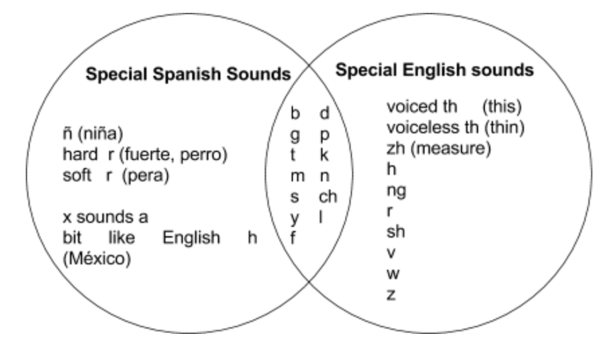by Jennifer Kirschner, M.S., CCC-SLP & Rebecca Fox, M.S., CCC-SLP (Speech-Language Pathologists in Chapel Hill-Carrboro City Schools
When native Spanish speakers are learning to speak English, many elements of their speech can sound “wrong” to native English speakers. It is important for English-speaking teachers and staff to recognize what characteristics of Spanish are normal to hear in English.
Language/ Grammar Differences Commonly Observed Among Spanish Speakers
When a child learns a second language sequentially (i.e. after having proficiency in a first language), grammatical errors will be present until s/he figures out the rules of the new language.
The effects of Spanish on English can result in errors in:
- verbs (“Did you take a decision?”)
- prepositions (“Put the soup on the bowl.”)
- pronouns (Pronouns are “built in” to Spanish verbs, i.e. “fue” for “he/she went.” Sometimes a Spanish speaker will use “her” instead of “his” or vice versa because the Spanish su means both.)
- word order (In Spanish, the word order is much more flexible than in English)
Most of these errors are considered developmental and are similar to ones children learning their first language make.
Encourage your students and their families to use their home language! When a person stops using their home language in favor of another, they may appear to “get” English faster, but they lose overall language proficiency in the long term. This results in a lack of rich language and diminishing ability to understand and express complex concepts. (Cummins, 2001)
Articulation Differences Commonly Observed among Spanish Speakers
(Roseberry-McKibbin, 1995)

- /t, d, n/ may be dentalized
- final consonants are often devoiced or omitted (i.e.: dose/doze)
- deaspirated stops
- /d and z/ often substituted for voiced /th/
- /t/ often substituted for voiceless /th/
- schwa sound is inserted before word initial consonant clusters (eskate/skate)
- final consonant deletion (Spanish words can end in 10 different sounds: a, e, i, o, u, l, r, n, s, d)
- when words start with /h/, the /h/ is silent
- /r/ is tapped or trilled
- Spanish /s/ if produced more frontally than English /s/
- nasal consonant may be velarized
- substitutions include: b/v, y/j, s/z, ch/sh, sh/ch, n/ng, ee/i, e/ae, ah/ae
- Spanish only has 5 vowel sounds (/a, e, i, o, u/). English shares those 5 vowels plus has 8 more additional vowel sounds.
Photo: Pixabay Public Domain



Great article that makes it easier for classroom teachers to work with their Spanish speaking students.
LikeLike